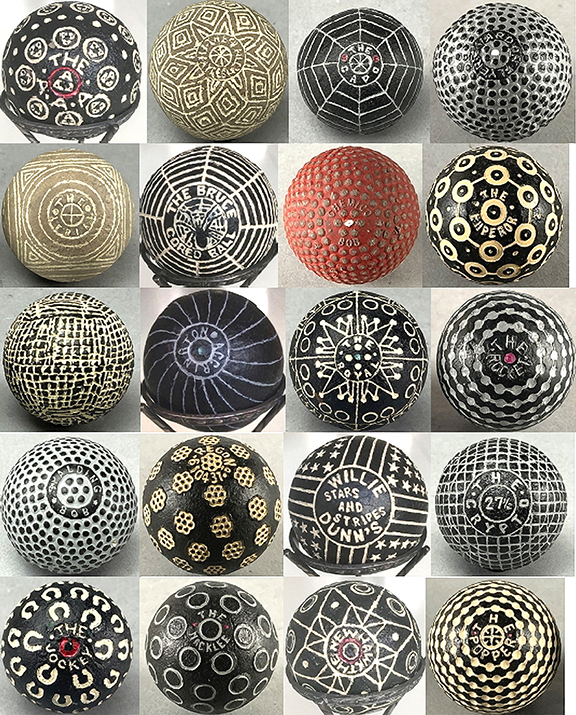Ah, that deceit should
steal such gentle shape,
And with a virtuous visor
hide deep vice!
Shakespeare, Richard III
Antique golf expert Jeff Ellis is more blunt than Shakespeare in his language with regard to counterfeit golf balls which he says are a great harm to the collecting community. What are they and how to spot them? In this article and on his website, Ellis shares tips that will help you spot what’s real and what’s not in antique golf balls.
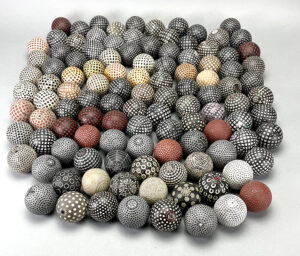
By Jeffery B. Ellis
(The Golf, Summer 2024)
In late 2022, I received a large collection of golf balls. Approximately half of them – well over 100 – had been “repainted,” the owner said, because they were found in lakes. As you can see in the image accompanying this article, these balls were not simply repainted white, however, as was the time-honored custom employed by the golfers of yesteryear. No, these balls were newly painted in two dramatically contrasting colors with black often being one of the two colors. I had seen what I call “decorated” two-color balls before, but never in such quantity as was delivered to my doorstep. Because I had seen far too many counterfeit antique golf clubs and knew many of the devious tricks used to make them and the fishy stories used to explain away their anomalies, I had my questions about the validity of these balls.* My examination of these balls, unfortunately, confirmed my suspicions.
*(Using 62 pages in the second edition of The Clubmakers Art: Antique Golf Clubs and Their History, I document over 76 fake and replica antique golf clubs.)
Of all the decorated balls I examined in detail and even invasively tested, which was about half of them, I was unable to validate even just one as genuine. Instead, they proved to be counterfeits. I found images on the internet of many other decorated balls that looked like they had been painted by the same person/group as had painted the balls I received. I also used images of genuine balls in their original paint with molded letters and patterns that, when placed side by side with various counterfeit balls, document the night and day difference between the genuine and the fake.
The full results of my 10-month study – “Counterfeits! Antique Golf Balls That Do Not Fly” – is found at www.antiqueclubs.com. Approximately 100 counterfeit balls are shown there along with genuine balls so the viewer can see the differences.
In the group of 100+ decorated balls I received, there were both counterfeit solid gutta percha balls purportedly from the 1890s and earlier, as well as counterfeit rubber-core balls purportedly from the early 1900s.
The counterfeit gutta percha balls were all genuine gutta percha balls made during the 1890s that had been materially modified. Some were once common mesh pattern balls that had been stripped of their old pattern and remade with a new and more valuable pattern, such as a Willie Dunn’s Stars and Stripes ball. Others had been stripped of just their name and then marked with a more valuable name, such as Harry Vardon, Willie Park, Tom Morris, etc. These name and pattern alterations are engraved/etched in place, not molded. This is the opposite of what it should be. ALL genuine gutta percha balls sold in the 1890s came out of molds. Hence, their patterns and lettering are molded. The scope of these bogus solid gutty balls extends far beyond the examples just cited.
The counterfeit early rubber core balls were produced in a few ways. In some instances, new design elements were engraved/etched onto the cover of an otherwise completely genuine ball, such as new lines that would connect the original dimples, turning an ordinary dimple ball into something far rarer and more valuable. In most instances, however, the original cover had been removed from an old rubber-core ball, and a new cover molded back on the wound core. This process is no different from how golf balls were recovered back in the early 20th century except for one thing: The covers on the counterfeit golf balls are made from synthetic rubber instead of organic gutta percha or a gutta percha composition, which was the cover material used on the vast majority of all early rubber core golf balls made between 1898, when they were introduced, and the 1920s.
Consequently, the covers of the counterfeit balls I examined were typically not the correct color of gutta percha and often did not make the correct sound when lightly bounced on a hard surface. Furthermore, synthetic rubber is oil-based, and the unpainted rubber covers I encountered were often slightly tacky, not slick like unpainted gutta percha in clean original condition. When I heated a few tiny pieces of these synthetic rubber covers, they would melt, smoke, and produce an unbearable smell like oil on fire.
Because most of these counterfeit balls are completely covered in paint, the rubber cover is not visible. The paint hides it. In many instances, I stripped paint off a portion of the cover to view the material underneath the paint. In every instance, the material was rubber, not gutta percha. Again, the vast majority of all early rubber-core golf balls made during the early 20th century had covers made from gutta perch or a gutta percha compound.
I also encountered a fair number of decorated balls with paint only in the pattern and no paint on the rest of the cover. In those instances, the unpainted area of the molded rubber cover was, again, not the correct color or texture of gutta percha. These covers not only looked and felt rubbery, but when tested they would typically work as an eraser, erasing a light pencil line off a piece of paper. This is something an unpainted gutta-percha-covered golf ball cannot do.
The molded rubber covers were produced in two main ways. The first way was to make an otherwise blank cover that could be engraved and/or stamped with either a valuable known pattern or a previously unknown pattern. And many crazy patterns were produced, but the counterfeiters were not crazy. Oftentimes, the crazier the pattern, the more a genuine ball will sell for. The names on these engraved pattern balls were also engraved. It’s not hard to trace lines and letters on a ball and then etch away. As mentioned, in some instances the pattern was hand-stamped into place.
To execute the engraved patterns, I believe the counterfeiters used silhouettes/outlines of valuable cover patterns made from scanned images. Overlaying the outline of a pattern onto an object, then tracing it onto the object, and then engraving away is nothing new. In the case of many of the engraved balls, the pattern is close to correct, only its badging and pattern is too large, which is what will happen if you take a 2-D image of a ball and then expand its size so it will cover half of an actual 3-D golf ball.
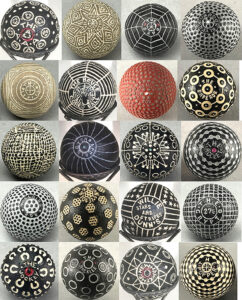
On his website, Ellis writes: “When a ball has been repainted in recent years, anything could be underneath the paint—filler, a sanded surface, remains of a different pattern/name, or even a new 21st-century cover. Black paint and fresh white engraving hide the original impression of the letters and pattern made by the mold, so those things are no longer available for inspection. They have been destroyed. Why do that to a genuine antique ball?”
Taking the above one step further, given that a dentist can wave a wand around the inside of a patient’s mouth and then output a perfect copy of their teeth, I don’t believe it would be hard to scan in an image and then output a mold or copy of a ball complete with the pattern on the scanned image. While I have not seen this done, there is no question that it can be done and will be done if it hasn’t already occurred.
The second method used to produce counterfeit balls was to make a soft mold using a genuine antique golf ball and then reproduce that ball in perfect detail. On the reproduced ball, the pattern and the name look perfect, only the cover is rubber and not gutta percha. Both rare high-value antique balls and more common antique balls were duplicated this way.
Additional differences between genuine and counterfeit golf balls are found in my online report. The second and third sections (1.2 and 1.3) are particularly helpful in understanding the differences. Those sections provide a foundational understanding of how antique golf balls were made, which is extremely helpful when trying to determine if the ball you are looking at might be old or a counterfeit.
I readily acknowledge that I do not know everything about the various ways that the counterfeiters plied their trade. Their techniques have evolved over the past 20 or so years, that is for sure, and I do not know the mechanics behind how they produced all of the different types of fakes that they made and continue to make. However, being able to recognize a counterfeit golf ball, autograph, watch, dollar bill, or anything else is far more important than knowing how it was made.
With all the angles the counterfeiters used to work their scam and the fact that there is no simple single test to identify all the various types of bogus balls, it can seem confusing to understand what is real and what is not. Just remember, when a genuine antique golf ball has been repainted, it has lost the foundational evidence of its originality. Because its original paint and any exposed gutta percha on any worn or chipped areas are no longer visible, the ball might have gutta percha under the new paint – or synthetic rubber. The pattern itself is no guarantee of authenticity. A wide variety of patterns have already been reproduced on a myriad of balls.
So, how does a collector know if what is supposed to be an early 20th-century rubber-core ball is genuine or not? Again, there is no single simple answer that works in every situation with every ball. Below, however, are some guide points to help collectors steer clear of inadvertently collecting counterfeits.
1. Any purported vintage/antique ball that has been newly painted in two contrasting colors has an extremely high chance of being counterfeit. Furthermore, black paint was used extensively on the counterfeit golf balls I examined. Black paint in and of itself is also a giant red, or should I say black, flag.*
*(I have seen two different antique golf balls that had a two-color cover. The first is the Challenger XL with an original paint black and white checkerboard pattern. When viewed close, the one genuine ball I saw showed a great deal of age, with discolored paint and cracks in the gutta percha cover, not just dried paint cracks. However, I have seen at least six Challenger XL checkerboard balls that have new paint, no signs of age, no cracks in the cover, and no chips in the paint. Nothing about these six balls verifies their purported age, and everything about them matches all the other two-color counterfeit balls I have examined. The second ball is the Flash Spot which also has a checkerboard pattern, but it used either gold or silver reflective paint in its recessed squares and white paint on its raised squares.)
2. Any purported vintage/antique ball that is painted only in its pattern and its unpainted area does not have the appearance/characteristics of gutta percha has an extremely high chance of being counterfeit. The vast majority of all the golf ball covers produced during the first few decades in the 20th century were made from gutta percha or a gutta percha composite. The counterfeit balls that purportedly date to the same time have rubber covers.
3. Any purported vintage/antique golf ball that has any portion of its pattern stamped or engraved onto its cover, even if only its name, has an extremely high chance of being counterfeit. All genuine antique golf balls had their names and patterns molded in place. Furthermore, engraving over a genuine name or pattern, even if only remaining in part, is to deface the ball and thereby eliminate any remaining value it might have once had. Why? Because nothing is left to validate the ball.
4. Any purported vintage/antique golf ball that lacks basic symmetry to parts of its design/pattern and or name has an extremely high chance of being a counterfeit. All genuine balls were made by skilled artisans who were masters at their craft. Everything about their work was neat and symmetrical.
Having said the above, I am also sure there is a small number of recently painted two-color decorated balls that are real (most likely lower-end stuff), but given the degree to which these counterfeit balls have penetrated the hobby, I simply cannot trust any recently painted, decorated, engraved, or asymmetrical pattern ball to be legitimate. And even if the ball under the black paint or a two-color scheme happens to be genuine, the paint has poisoned it.
There can be no doubt that the counterfeiters have read my work posted online and are updating their methods to try and have their fakes appear more legitimate, either that or other nefarious individuals will eventually try to take advantage of this market, as it can be lucrative. The money paid to date for counterfeit golf balls likely totals into the millions of pounds. I speak in terms of pounds as the counterfeit balls I have encountered originated from the U.K., although they have long been sold and resold all over the U.S. at collector shows and on eBay.
In the future, as two-color and black painted balls become understood for what they are, I expect more counterfeit balls will be painted solid white. When it comes to single-color repainted balls, I advise collectors to be extremely confident that such a ball is legitimate before making a purchase. New repaints done in the last 20 years, which continue to come onto the market, can sometimes be tricky to discern without stripping paint.
Given the extent to which the counterfeiters have already gone to work their despicable craft, and the fact that powerful technology can be brought into play if it has not been already, ball collectors need to be diligent in their efforts. To that end, the purpose of my study, research, and testing of these balls was to inform the golf-collecting world of the giant travesty that has been perpetrated on the hobby for upwards of 20 or more years now. And of that, there is no question.
Today, there are now thousands of two-color decorated golf balls in circulation and in a wide variety, much wider than any one person understands – other than the perpetrators. Again, the two colors are not simply used for decoration, as engaging as these balls might be. They are used to distract from if not completely hide the fraud behind the ball.
Bottom line, this is a crime of major proportions that its victims should report to the authorities.
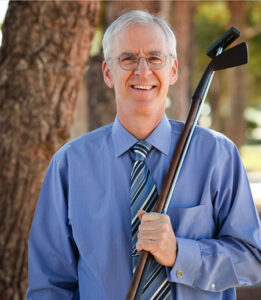
Jeffery Ellis is a longtime GHS member who is known for his authoritative books on antique golf clubs – The Clubmaker’s Art: Antique Golf Clubs & Their History (1997) and The Golf Club: 400 Years of The Good, The Beautiful, and The Creative (2002). Jeff has recently joined Golden Age Auctions as its antique golf equipment expert. He also maintains a website at www.antiqueclubs.com where his many articles on antique golf equipment are an important resource for collectors.
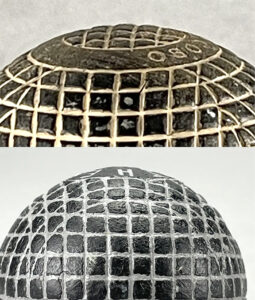
During his 10-month study of counterfeit golf balls, author Jeff Ellis examined a variety of name brand golf balls, all described in the referenced website article in great detail. At right is an example of just one ball and a particular discrepancy that raised his suspicions and serves as a giveaway to the ball’s authenticity, or lack thereof. Here, Ellis describes how an examination of the lettering may help reveal the counterfeiter’s art. The bottom photo shows the pole of a “Crypto” golf ball. The top photo is of an authentic “Ocobo” golf ball. Ellis writes:
The “H” in “THE” is on a different plane/angle than the “T”, and the “E” is on a different plane of its own. This is evidence that the original letters were sanded off the ball and new letters installed. The lettering on the ball shown above is all on the same plane.

